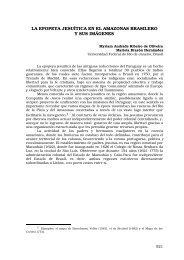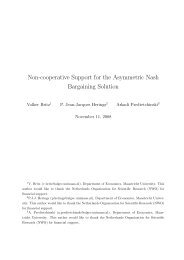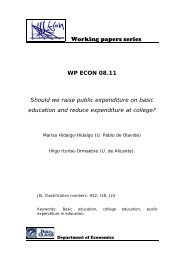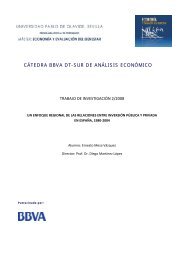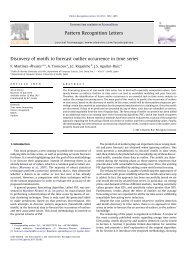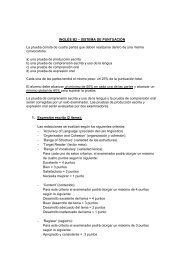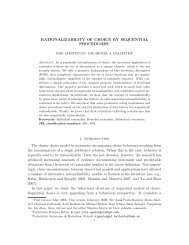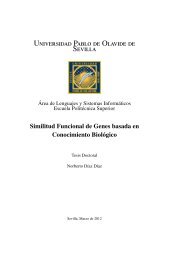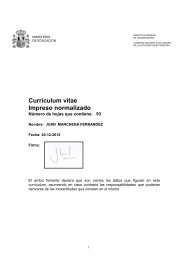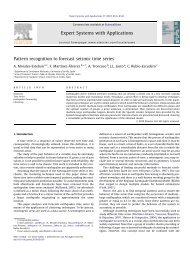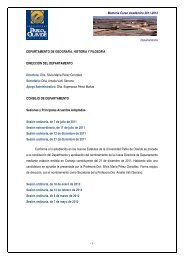Working paper series WP BSAD 11.03 - Universidad Pablo de Olavide
Working paper series WP BSAD 11.03 - Universidad Pablo de Olavide
Working paper series WP BSAD 11.03 - Universidad Pablo de Olavide
You also want an ePaper? Increase the reach of your titles
YUMPU automatically turns print PDFs into web optimized ePapers that Google loves.
D e p a r t a m e n t o d e<br />
D i r e c c i ó n d e E m p r e s a s<br />
D e p a r t a m e n t o d e<br />
D i r e c c i ó n d e E m p r e s a s<br />
<strong>Working</strong> <strong>paper</strong> <strong>series</strong><br />
<strong>WP</strong> <strong>BSAD</strong> <strong>11.03</strong><br />
The Role of Stakehol<strong>de</strong>rs in Accounting of Private Patrimonies:<br />
The Management Of The Osuna Ducal Estate (1590-1633)<br />
Jesus Damian López Manjón<br />
<strong>Universidad</strong> <strong>Pablo</strong> <strong>de</strong> Olavi<strong>de</strong> <strong>de</strong> Sevilla<br />
Department of Business Administration<br />
(jdlopman@upo.es)<br />
DEPARTMENT OF BUSINESS ADMINISTRATION<br />
1
D e p a r t a m e n t o d e<br />
D i r e c c i ó n d e E m p r e s a s<br />
THE ROLE OF STAKEHOLDERS IN ACCOUNTING OF PRIVATE<br />
PATRIMONIES: THE MANAGEMENT OF THE OSUNA DUCAL<br />
ESTATE (1590-1633)<br />
July 2011<br />
Jesus Damian López Manjón<br />
Department of Business Administration<br />
<strong>Universidad</strong> <strong>Pablo</strong> <strong>de</strong> Olavi<strong>de</strong><br />
Carretera <strong>de</strong> Utrera, km. 1<br />
41013 Seville (Spain)<br />
Phone: + 954 34 98 43, Fax: 954 34 83 53<br />
Abstract<br />
The main aim of this <strong>paper</strong> is to test the validity of the stakehol<strong>de</strong>r approach in a historical context (16th and<br />
17th century), very different to the one in which the theory was originally <strong>de</strong>veloped and has normally been<br />
used. For this purpose, the <strong>paper</strong> <strong>de</strong>als with management in the Osuna Ducal Estate at the end of the 16th<br />
century and beginning of the 17th century. In that period, the Ducal Estate reached such a high level of<br />
in<strong>de</strong>btedness that creditors could not even collect the interest on their loans. This led them to lodge a<br />
complaint with the Crown and consequently, as of 1590, the Ducal Estate patrimony was seized by the<br />
Government. Since the changes that occurred in the ODE patrimony were promoted by creditors and the<br />
Crown, the stakehol<strong>de</strong>r approach has been applied to analyse the case. We can conclu<strong>de</strong> that stakehol<strong>de</strong>r<br />
approach is sufficiently able to explain the changes that took place in the management of the Osuna Ducal<br />
Estate in the 16th and 17th century and, mainly, the role of accounting in these changes.<br />
Keywords: Accounting History, Stakehol<strong>de</strong>r Approach, Aristocratic Accounting, 16th and 17th century<br />
With financial support of ECO 2008-06052: “Accounting as a Social and Institutional Practice: Past and<br />
Present Analysis”,: Spanish Science Ministry and SEJ 4129 “Andalusia, Crossing of cultures. A View from<br />
Accounting”, Andalusian Regional Government<br />
2
D e p a r t a m e n t o d e<br />
D i r e c c i ó n d e E m p r e s a s<br />
THE ROLE OF STAKEHOLDERS IN ACCOUNTING OF PRIVATE<br />
PATRIMONIES: THE MANAGEMENT OF THE OSUNA DUCAL ESTATE<br />
(1590-1633)<br />
1. Introduction<br />
“The stakehol<strong>de</strong>rs approach is about groups and individuals who can affect the<br />
organization and is about managerial behaviour taken in response to those groups and<br />
individuals” (Freeman, 1984, p. 48). This <strong>de</strong>finition by Freeman can be consi<strong>de</strong>red the first<br />
step in the stakehol<strong>de</strong>r approach. In or<strong>de</strong>r to i<strong>de</strong>ntify stakehol<strong>de</strong>rs, Freeman ad<strong>de</strong>d “any<br />
group or individual who can affect or is affected by the achievement of the firm’s<br />
objectives” (1984, p. 25).<br />
Stakehol<strong>de</strong>rs approach has been used in accounting research, especially for the study<br />
of the social and environmental accounting, and fundamentally for cases of organizations<br />
with spirit of profit. Nevertheless, its validity has not been tested for the analysis of the role<br />
of accounting in private patrimonies.<br />
Besi<strong>de</strong>s, the stakehol<strong>de</strong>r approach has not been used frequently to study historic cases.<br />
We can quote two recent studies: i) the <strong>paper</strong> by Chandar and Miranti Jr (2007) on the<br />
process of firm-specific learning relating to the <strong>de</strong>velopment of actuarially based pension<br />
accounting at the Bell System in the USA from 1913 to 1940 and ii) the work by Cámara et<br />
al. (2009) on the evolution of annual reports of the Spanish Tobacco Monopoly between<br />
1887-1986 as answer to the changing requirements of the stakehol<strong>de</strong>rs.<br />
This <strong>paper</strong> <strong>de</strong>als with changes happened in accounting and management in the<br />
Osuna Ducal Estate (hereinafter ODE), one of the most important Spanish Aristocratic<br />
organizations, during the end of the 16 th century and first part of the 17th. Thus, the case<br />
3
D e p a r t a m e n t o d e<br />
D i r e c c i ó n d e E m p r e s a s<br />
allows to us to test the accuracy of stakehol<strong>de</strong>r approach to explain changes in accounting<br />
and management in private patrimonies and in historical contexts.<br />
Aristocratic organizations were one of the more important private organizations in<br />
the history of the Spanish economy. In the epoch of the first three Austrias the king, the<br />
clergy and the nobility were possessing 95 % of the land in Spain (Reglá, 1974).In this<br />
way, 40 % of the land in Andalusia in the 17 th century was in aristocrats' hands (Bernal,<br />
1983). In addition, Aristocratic Estates involving the transfer of public competitions in<br />
matters of administration and government, justice and taxes (Atienza, 1987). So,<br />
Aristocratic Estates were forming a part of the gear of the "State system” in the Spain of<br />
the 16 th and 17 th century.<br />
However, little research has been conducted into the management of aristocratic<br />
estates as several authors have pointed out (for instance, Ezzamel, 2002; Hernan<strong>de</strong>z<br />
Esteve, 2008). As far as Spain is concerned, Hernán<strong>de</strong>z Esteve (2005) pointed out that, in<br />
spite of its interest, accounting of the Aristocratic Estates and of landowners continues<br />
being a "minimally explored" topic.<br />
At the end of 16 th century, ODE reached such a high level of in<strong>de</strong>btedness that<br />
creditors could not even collect the interest on their loans. This led them to lodge a<br />
complaint with the Crown and consequently, as of 1590, the Ducal Estate patrimony was<br />
seized and managed by the Government. Therefore, the Government set out a <strong>series</strong> of the<br />
rules to manage the ODE patrimony. However they did not manage it directly but rather<br />
auctioned it off publically or appointed administrators.<br />
Since the changes that occurred in the ODE patrimony were promoted by creditors<br />
and the Crown (agents who can influence on and be influenced by the organization, ODE),<br />
we have used the stakehol<strong>de</strong>r approach has been applied to analyse the case. From its<br />
4
D e p a r t a m e n t o d e<br />
D i r e c c i ó n d e E m p r e s a s<br />
analysis, we can extract that stakehol<strong>de</strong>r approach can be used to explain the role of<br />
accounting in the management of private patrimonies and in a very previous historical<br />
period to in that till now it has used.<br />
The primary sources used in this research had been taken from the National<br />
Historical Archive, Nobility Section, (hereinafter SNAHN) housed in the Tavera Hospital,<br />
Toledo, and the Public Archive of Osuna in the collection from the Rodriguez Marin<br />
archive (hereinafter AMO).<br />
2. The I<strong>de</strong>ntification of Salience of Stakehol<strong>de</strong>rs<br />
Mitchel et al. published in 1997 a <strong>paper</strong> aimed to formulate a theory of stakehol<strong>de</strong>r<br />
i<strong>de</strong>ntification and salience able to explain to whom and to what managers actually pay<br />
attention. That <strong>paper</strong> constitutes the theoretical basis used in our work. Michel et al. (1997)<br />
indicated that the three key attributes of a stakehol<strong>de</strong>r are urgency, legitimacy and power.<br />
Depending on the combination of these factors, managers will have to pay more or less<br />
attention to a stakehol<strong>de</strong>r.<br />
In or<strong>de</strong>r to <strong>de</strong>fine power, these authors follow Dahl, 1957, Pfeffer, 1981, and<br />
Weber, 1947, <strong>de</strong>scribing it as “a relationship among social actors in which a social actor,<br />
A, can get another social actor, B, to do something that B would not have otherwise done”<br />
(ib., p. 869). Within their framework, they use the legitimacy <strong>de</strong>finition offered by<br />
Suchman: “a generalized perception or assumption that the actions of an entity are<br />
<strong>de</strong>sirable, proper, or appropriate within some socially constructed system of norms, values,<br />
beliefs, and <strong>de</strong>finitions” (1995, p. 574 quoted in ib., p. 866). Urgency is <strong>de</strong>fined in the<br />
aforementioned <strong>paper</strong> as “the <strong>de</strong>gree to which stakehol<strong>de</strong>r claims call for immediate<br />
attention” (ib., p. 869).<br />
5
D e p a r t a m e n t o d e<br />
D i r e c c i ó n d e E m p r e s a s<br />
The key contribution of Mitchell et al. is the addition of urgency to the list of<br />
stakehol<strong>de</strong>r attributes in or<strong>de</strong>r to change the mo<strong>de</strong>l from static to dynamic (ib., 867).<br />
Moreover, these authors pointed out several additional features of the attributes. First of<br />
all, they are variable, not a steady state. They can be gained and they can be lost. They are<br />
socially constructed rather than objective realities. Finally, neither the stakehol<strong>de</strong>r nor the<br />
managers are always conscious of their attributes. Even if such awareness exists, there is<br />
not always a wilful exercising of these attributes (ib., 868).<br />
Based on these attributes, Mitchell et al. drew up a classification of stakehol<strong>de</strong>rs. It<br />
is remarkable that the point is not the existence or not of the attribute but rather the<br />
managerial perception regarding the existence of these attributes. Thus, they <strong>de</strong>fine latent<br />
stakehol<strong>de</strong>rs as those for which the manager perceives the presence of only one attribute.<br />
Expectant stakehol<strong>de</strong>rs are those for which the manager perceives the presence of two<br />
attributes. If the manager perceives the presence of the three attributes, stakehol<strong>de</strong>rs are<br />
named <strong>de</strong>finitive stakehol<strong>de</strong>r.<br />
The dynamism of the mo<strong>de</strong>l allows for stakehol<strong>de</strong>rs to change their position in the<br />
previous classification by gaining or losing attributes. In the first two categories, the<br />
authors establish sub-sets <strong>de</strong>pending on the perceived attributes. Specifically within the<br />
category of expectant stakehol<strong>de</strong>rs, they distinguish:<br />
1. Dominant stakehol<strong>de</strong>rs. When the manager perceives the presence of power and<br />
legitimacy.<br />
2. Dependant stakehol<strong>de</strong>rs. When the manager perceives the presence of legitimacy<br />
and urgency. They are called <strong>de</strong>pendant because their lack of power means they<br />
need the help of other groups/individuals (manager or stakehol<strong>de</strong>r) in or<strong>de</strong>r to<br />
achieve their objectives.<br />
6
D e p a r t a m e n t o d e<br />
D i r e c c i ó n d e E m p r e s a s<br />
3. Dangerous stakehol<strong>de</strong>rs. When the manager perceives the presence of power and<br />
urgency. The absence of legitimacy usually leads to the use of violent and coercive<br />
measures.<br />
As far as latent stakehol<strong>de</strong>rs, they distinguish: dormant stakehol<strong>de</strong>rs if only power is<br />
perceived; discretionary stakehol<strong>de</strong>rs when their only perceived attribute is the legitimacy;<br />
and <strong>de</strong>manding stakehol<strong>de</strong>rs who are those for which urgency is the only perceived<br />
attribute.<br />
The authors propose that the salience of a stakehol<strong>de</strong>r <strong>de</strong>pends on the combination<br />
of attributes perceived by the managers (ib. 873). Thus, the level of salience will be high<br />
for <strong>de</strong>finitive stakehol<strong>de</strong>rs, medium for expectant stakehol<strong>de</strong>rs and low for latent<br />
stakehol<strong>de</strong>rs.<br />
3. The Osuna Ducal Estate<br />
ODE inclu<strong>de</strong>d the group of aristocratic dominions that belonged to the jurisdiction of the<br />
Dukes of Osuna. Aristocratic dominion did not necessarily imply the ownership of the<br />
lands but rather the possibility of promulgating rules, collecting taxes, imparting justice in<br />
the first instance, enjoying several monopolies and the capacity of founding patronages. In<br />
other words, the Dukes were not the owners of all the lands over which they had<br />
jurisdiction and they did not have jurisdiction over all the lands they owned.<br />
The ODE comprised dominions located in two separated areas: Andalusia and<br />
Castile 1 and originally organised into three districts named after their respective capitals:<br />
Osuna, Ureña and Peñafiel 2 . Andalusian territories belonging to ODE together with those<br />
1 Central tableland of Spain.<br />
2 Osuna inclu<strong>de</strong>d Arahal, Archidona, Morón, Olvera, Ortegicar, Puebla <strong>de</strong> Cazalla and the capital, all of them<br />
situated in Andalusia. Ureña and Peñafiel were located in Castile. Gumiel <strong>de</strong> Izán, Briones and Arévalo<br />
7
D e p a r t a m e n t o d e<br />
D i r e c c i ó n d e E m p r e s a s<br />
of Medina-Sidonia, Arcos, Medinaceli and Infantado, was one of five big lordly<br />
Andalusian dominions of the Ancient Regime. Osuna had the advantage opposite to the<br />
remaining ones of the proximity of the villas and places that were composing it, forming a<br />
"continuum territorial” (Atienza, 1987).<br />
The ODE was foun<strong>de</strong>d in 1562 when King Phillip II bestowed upon Pedro Téllez<br />
Girón (1531-1562) the title of Duke of Osuna. Previously the Téllez Girón family used the<br />
title of Count of Ureña, and the first Duke was the fifth Count of Ureña. ODE properties<br />
were divi<strong>de</strong>d into entailed and free goods. The entailed goods were inclu<strong>de</strong>d in the<br />
mayorazgo 3 . In the period studied, the ODE was one of the most important aristocratic<br />
estates in Spain in terms of the rents collected. The chronicler Pedro Núñez Salcedo<br />
(quoted by Reglá, 1974, pp. 45-46) realized a list of the most important financiers of Spain<br />
in the period 1597-1600 figuring Osuna's Estate thirdly with 150.000 ducados of annual<br />
revenue. Nevertheless, at the end of the 16th century, ODE was strongly in<strong>de</strong>bted, situation<br />
that was common in the Spanish nobility in that epoch (Domínguez Ortiz, 1983; Yun,<br />
2002).<br />
4. The Context<br />
The political and economic situation in Spain un<strong>de</strong>rwent changes in the period examined<br />
here. King Philip III (1578-1621) succee<strong>de</strong>d his father Phillip II (1527-1598) to the throne.<br />
formed the Peñafiel district and Tiedra, Pobladura, Villafrechos, Villa<strong>de</strong>fra<strong>de</strong>s and Villamuriel ma<strong>de</strong> up the<br />
Ureña district.<br />
3<br />
The mayorazgo (The Osuna mayorazgo was foun<strong>de</strong>d in 1511) was a Spanish legal institution that meant<br />
that a set of properties was entailed as an indivisible unit. Those goods could not be sold, mortgaged or<br />
divi<strong>de</strong>d unless specific Royal authorisation was granted. The only possible means of transmission was by<br />
inheritance in favour of the first-born. Its proposal guaranteed that the whole of the family patrimony would<br />
be kept together.<br />
8
D e p a r t a m e n t o d e<br />
D i r e c c i ó n d e E m p r e s a s<br />
Phillip III had a weak character and granted power to his favourites who became the main<br />
figures of authority in the Kingdom 4 .<br />
The agricultural situation is especially important for the purposes of this <strong>paper</strong> since<br />
it was the main source of income for the ODE. It suffered stagnation with annual increases<br />
of between 2% and 4% (Burrell, 1988, p. 440). The agricultural market was regulated.<br />
Thus, the Government promulgated an official rate, which was the maximum price allowed<br />
for the sale of wheat and barley. However, at least in the period 1558-1605, the market<br />
prices of wheat and barley were higher than the official rate (Reglá, 1974, p. 14).<br />
During the reigns of Charles V and Phillip II, the nobles retained jurisdictional<br />
privileges in their districts but they were kept away from the Court and the country’s<br />
affairs of state. As mentioned previously, Phillip III gave his power to the Duke of Lerma<br />
and from this reign onwards, the Nobility gained influence and presence in the Court,<br />
occupying most government positions. The influence of Spanish aristocracy rose<br />
throughout the 16 th century favoured by their control of the grain market (Bernal, 1983, p.<br />
250; Yun, 2002, p. 20), and the social alliance with the crown. During the first three reigns<br />
of the Hapsburg dynasty, the crown, the clergy and the aristocracy owned 95% of Spanish<br />
lands (Reglá, 1974, p. 24). Aristocracy owned 40% of arable land in Andalusia in the 16 th<br />
century (Bernal, 1983, p. 260).<br />
In spite of their power and influence, most Spanish aristocratic organisations had a<br />
high level of in<strong>de</strong>btedness at the end of the 16 th and beginning of the 17 th century . The<br />
literature provi<strong>de</strong>s different reasons to justify this seemingly contradictory situation. Thus,<br />
Domínguez Ortiz (1983, p. 301) blames the inappropriate management of patrimonies and<br />
the high level of non-productive assets. Atienza (1987, p. 339 and following) follows this<br />
4 The Duke of Lerma occupied the position of Head Minister in 1599.<br />
9
D e p a r t a m e n t o d e<br />
D i r e c c i ó n d e E m p r e s a s<br />
opinion and adds other reasons such as the necessity of providing economically for<br />
relatives exclu<strong>de</strong>d from the mayorazgo inheritance and high crown taxes.<br />
Yun (2002), however, does not agree with these authors regarding the<br />
mismanagement of aristocratic patrimonies. In his view, there were reasons for<br />
in<strong>de</strong>btedness out of the control of their mangers such as the social and legitimising<br />
functions of the lordships, the services ren<strong>de</strong>red to the crown or the irregularity of income<br />
that <strong>de</strong>pen<strong>de</strong>d on the circumstances of the agricultural market every year. Furthermore, the<br />
aristocracy had to pay out large sums at specific moments, for instance, the dowries<br />
payable when their daughters married or the aforementioned services to the Crown.<br />
Putting the reasons to one si<strong>de</strong>, the fact of the matter is that at the end of the 16 th<br />
and beginning of the 17 th century, the crown had to help solve the aristocracy’s financial<br />
problems, by taking its properties into administration and reducing the censos interest rate<br />
(Domínguez Ortiz, 1985; Yun, 2002).<br />
5. ODE Management<br />
This section <strong>de</strong>als with the different administrative rules promulgated for the ODE in the<br />
period of study. As of 1590, the ducal patrimony was seized by the Crown and managed by<br />
members of the Council of Castile. This next point <strong>de</strong>als with that intervention, followed<br />
by a <strong>de</strong>scription of the rules promulgated for the whole lease of the ducal patrimony<br />
carried out as of 1599. As we have said before, the members of the Council of Castile<br />
appointed to administer the ducal patrimony promulgated an Instruction regarding<br />
accounting procedures in 1605. The clauses inclu<strong>de</strong>d in this Instruction are studied below.<br />
The Duke, his creditors, and guarantors reached an agreement in 1606 regarding the<br />
administration of the patrimony which was ratified by the Crown. The last point <strong>de</strong>als with<br />
10
D e p a r t a m e n t o d e<br />
D i r e c c i ó n d e E m p r e s a s<br />
the <strong>de</strong>cision ma<strong>de</strong> by the King to assign administration of the ducal patrimony back to the<br />
dukes.<br />
5.1. Royal Intervention<br />
The progressive in<strong>de</strong>btedness of the ODE led creditors and guarantors to lodge complaints<br />
and initiate several litigation proceedings in different Tribunals. The Crown was interested<br />
in resolving this problem because the ODE, like other aristocratic estates, was one of the<br />
politic and economical mainstays of the Crown. Hence, its potential bankruptcy and<br />
disappearance would have negative consequences for the Monarchy. Furthermore, most of<br />
the Estate’s <strong>de</strong>bts had required royal authorisation since they affected properties entailed<br />
through mayorazgo.<br />
The Crown <strong>de</strong>ci<strong>de</strong>d to seize the ducal patrimony from 1590 onwards, and<br />
promulgated the following rules:<br />
• Transferring the management of ducal patrimony to the Council of Castile. They<br />
did not manage it directly but appointed an administrator in charge of ducal<br />
patrimony.<br />
• Drawing up a rating of creditors to ensure the correct payment of <strong>de</strong>bts. In this<br />
rating, <strong>de</strong>bts were or<strong>de</strong>red chronologically. The result of this rating was that in<br />
1594 ODE accumulated 194 <strong>de</strong>bts for 264,992,395 maravedíes and had to pay<br />
14,765,726 maravedíes annually in interest.<br />
• Limiting proceedings to all the usual tribunals. All cases pertaining to the ODE had<br />
to be legally brought before the Council of Castile.<br />
The administrator Cristobal <strong>de</strong> Auleztia, <strong>de</strong>signated by the Council of Castile, received<br />
complaints from creditors about the accounts presented by some of the ODE’s collectors.<br />
11
D e p a r t a m e n t o d e<br />
D i r e c c i ó n d e E m p r e s a s<br />
AMO keeps several accounts submitted by collector of the ODE Andalusian district<br />
coming from 1594. During this period, the ODE had a collector in each village of the<br />
district. This person was in charge of the collections of the rents and the payments related<br />
to the ODE. Periodically, irregularly but always for periods bigger than a year, the<br />
collectors reported accounts to the ODE using the system <strong>de</strong>fined in the Tratado <strong>de</strong><br />
Cuentas by Diego <strong>de</strong>l Castillo as the Cargo y Descargo. As an example of these accounts,<br />
we present the informative flows inclu<strong>de</strong>d in the accounts submitted by Rodrigo López,<br />
Archidona’s collector for the period 1592-93 (Diagram 1).<br />
Diagram 1. Example of informative flows of collectors accounts in the period 1590-1594<br />
Thus, Francisco <strong>de</strong> Santan<strong>de</strong>r, on his own behalf and representing other creditors,<br />
presented in 1594 claims about the accounts of Andres Banegas, Olvera’s collector, and<br />
about Rui Díez Roldan, who was La Puebla’s collector (AMO, file 13 (53)). Santan<strong>de</strong>r<br />
12
D e p a r t a m e n t o d e<br />
D i r e c c i ó n d e E m p r e s a s<br />
argued that the mistakes ma<strong>de</strong> in the settlement processes harmed his interests and those of<br />
other creditors, so the accounts should be re-drawn up. Most of the objections were<br />
common to both accounts:<br />
• The charge should inclu<strong>de</strong> rents pertaining to 1590 but collected in 1591 since the<br />
rents pertaining to 1593 but collected in 1594 were not inclu<strong>de</strong>d. By doing this, the<br />
charge would inclu<strong>de</strong> a complete period of three years.<br />
• During 1591, rents were levied and, therefore, the discharges of this year should not<br />
be admitted because the Collector could not pay those amounts.<br />
• There were previous periods in which the collectors occupied these positions and<br />
for which there are no settled accounts.<br />
• It has taken a single discharge for the whole period for which the creditors could<br />
have used one-year letters of payment to justify payments in other years.<br />
• There were payment receipts signed by unauthorised individuals.<br />
• The money received for the sale of wheat and barley was higher than the amount<br />
charged. That is so because the market price was higher than the official rate and<br />
the receipts may have been be falsified.<br />
• The administrator Cristobal <strong>de</strong> Auleztia had to pay the ducal family maintenance<br />
allowance. Thus, these quantities would not be inclu<strong>de</strong>d in the discharge to avoid<br />
paying it twice.<br />
Furthermore, in the case of Andres Banegas, the creditor argued that the Olvera Cilla 5<br />
remained closed for part of the period covered by the accounts. Therefore, the Collector<br />
must have sold wheat and barley outsi<strong>de</strong> of it. These quantities have not been charged.<br />
5 A Cilla was a grain warehouse where the ceral that correspon<strong>de</strong>d to the duke’s tithe was <strong>de</strong>posited.<br />
13
D e p a r t a m e n t o d e<br />
D i r e c c i ó n d e E m p r e s a s<br />
5.2. The whole lease<br />
Royal intervention was not successful. Management by the Council of Castile did not solve<br />
the problems of non-payment to the duke’s creditors. Thus, in 1598 the duke’s creditors<br />
asked the Crown once again to pass new rules about the administration of ducal patrimony.<br />
They argued that the accounts submitted by Cristobal <strong>de</strong> Auleztia, who managed<br />
the patrimony in the period 1594-96, inclu<strong>de</strong>d collections of one hundred and forty-eight<br />
million maravedíes during these three years. But he had only paid thirty-five million<br />
maravedíes in <strong>de</strong>bts and twenty-two in salaries assigned by the duke and Cristobal <strong>de</strong><br />
Auleztia himself; “the rest had been spent in maintenance allowance of the ducal family,<br />
costs and expenses and on taxes”. They claimed that the appointed administrators were<br />
only looking for own profit and that, in their opinion, the salaries <strong>de</strong>signed for the Duke’s<br />
staff were excessive. The result of Royal Intervention, according to the creditors’<br />
complaints, was an increase in total <strong>de</strong>bt of one hundred and fifty thousand ducados from<br />
the start of royal administration (in other words 21.23%).<br />
The solution put forward by the Crown, at the proposal of the creditors and<br />
guarantors, with the agreement of the Duke, was the whole lease of the ducal patrimony.<br />
The king appointed the Bachelor Tejada, member of the Council of Castile, to organise and<br />
control the lease.<br />
The minimum price fixed by Tejada was 133.000 ducados annually. Only one<br />
person, Gaspar <strong>de</strong> Zárate presented an offer and the final price fixed was 138.062 ducados<br />
every year with 3.000 as prometido 6 . The contract was transferred to Hernán Salcedo in<br />
1604. Upon expiry it was not renewed. Thus, from 1608 Gil Rámirez <strong>de</strong> Arellano, member<br />
of the Council of Castile, was appointed to manage the ducal patrimony.<br />
14
D e p a r t a m e n t o d e<br />
D i r e c c i ó n d e E m p r e s a s<br />
According to the Inventory of accounts of 1585-1663 submitted by the leasehol<strong>de</strong>rs of the<br />
whole patrimony, the Bachelor Tejada passed an edict on 7 th September 1601 advising the<br />
Duke’s accountant to be present at the settlement of accounts for Gaspar <strong>de</strong> Zárate.<br />
5.3. The 1605 Instruction on Accounting<br />
Members of the Council of Castile appointed for ODE administration passed this<br />
Instruction in Valladolid on July 16 th , 1605. The first step was to organise the ducal<br />
dominions into two districts: Andalusia and Castile 7 , each one with an Administrator and a<br />
safe used for the custodianship of ODE money. Diagram 2 shows the administrative<br />
organisation of the ducal Estate inclu<strong>de</strong>d in this Instruction.<br />
Diagram 2. Organisation chart of the Osuna’s Ducal Estate according to the Instruction of<br />
1605 (from Atienza, 1987, p. 320)<br />
6 Prometido: Sum given to the bid<strong>de</strong>rs in the public auctions for the lease of the royal rents with charge to<br />
the total of the leased rent.<br />
15
D e p a r t a m e n t o d e<br />
D i r e c c i ó n d e E m p r e s a s<br />
As far as accounting documentation is concerned, the Instruction indicated that each<br />
district should draw up:<br />
1. Account and Reason Book for the amounts <strong>de</strong>posited in the safe.<br />
2. Current Account Book for the amounts <strong>de</strong>posited in the safe.<br />
3. Account and Reason Book for payments.<br />
4. Implicitly, the Instruction mentions the accounts settled in the safe because the<br />
former book should be used to control the discharge of that account.<br />
5. Biannual report on the profit, value and leasing of rents.<br />
6. Biannual report of the amounts <strong>de</strong>posited and paid for the safe and overdue credits.<br />
The Osuna district should also draw up a biannual list of the surplus sent to the<br />
Court safe.<br />
Diagram 3 shows the flow of information inclu<strong>de</strong>d in the rule.<br />
7 Where the districts of Peñafiel and Ureña were joined.<br />
16
D e p a r t a m e n t o d e<br />
D i r e c c i ó n d e E m p r e s a s<br />
Diagram 3. Information flows inclu<strong>de</strong>d in the Instruction on Accounting of 1605<br />
The members of the Council of Castile, Diego López <strong>de</strong> Ayala, Pedro <strong>de</strong> Tapia and<br />
Fernando Carrillo signed the Instruction. On the same date, the judges ad<strong>de</strong>d the following<br />
rules regarding the way in which payments should be authorised:<br />
i. All <strong>de</strong>bts should be settled in the presence of the official in charge of sequestered<br />
property and the Accountants. Payments shall be ma<strong>de</strong> to each creditor as seen fit<br />
according to their credit and rating.<br />
ii. All payments had to be approved by the administration board. Accountants should<br />
report the leasing of any <strong>de</strong>bt and the position assigned according to the rating. The<br />
relevant payment authorisation had to be issued, for which the accountants had to<br />
provi<strong>de</strong> justification from the credit and <strong>de</strong>bit book for the District. Accounts entries<br />
17
D e p a r t a m e n t o d e<br />
D i r e c c i ó n d e E m p r e s a s<br />
for payments were ma<strong>de</strong> according to the lists sent by treasurers of the safes to the<br />
board so that these amounts could be released to the Accountants.<br />
Finally, the judges or<strong>de</strong>red the Accountants to draw up a new rating of creditors (since the<br />
current one was incomplete) accompanied by the <strong>de</strong>fensor <strong>de</strong> bienes (official in charge of<br />
sequestered property) of Castile. This new rating should be a correspon<strong>de</strong>nt to the<br />
administration board, to be inscribed in the books and sent to the Safes 8 . Apart from the<br />
new <strong>de</strong>bts rating, we do not have evi<strong>de</strong>nce of the fulfilment of this Instruction. In fact, little<br />
later the Duke and his creditors reached an agreement to change the form of management<br />
of the ducal patrimony.<br />
5.4. Agreements with creditors<br />
The ODE’s creditors and guarantors reached an agreement with the Duke regarding the<br />
management of ducal patrimony because they were not satisfied with the result achieved<br />
by the whole lease of the patrimony. This agreement was signed in Brussels on February<br />
9 th , 1604 and its signatories required royal authorisation and ratification.<br />
In the prologue to his Ratification Or<strong>de</strong>r (SNAHN, Osuna, file 3433/13), the King<br />
tackled the failure of the previous system of management, which he laid at the door of<br />
those members of the Council of Castile who were in charge of all matters pertaining to the<br />
ducal patrimony, having limited the ordinary tribunals:<br />
“And although it was passed so that the Estate would be better managed and the<br />
outstanding <strong>de</strong>bts paid without the costs previously entailed by collection, not only<br />
8 This new creditors rating (SNAHN, Osuna, file 1.494 (3)) registered 350 <strong>de</strong>bts with a capital of<br />
383.591.939 maravedíes and the payment of 21.498.920 of maravedíes in annual interest. That meant a rise<br />
of 80.41% in the number of <strong>de</strong>bts, 44.76% in capital and 45.60% in interest in relation to the rating of 1594.<br />
However not all of this increase was due to new <strong>de</strong>bts but rather to the inclusion in the 1606 rating of <strong>de</strong>bts<br />
18
D e p a r t a m e n t o d e<br />
D i r e c c i ó n d e E m p r e s a s<br />
were these objectives not achieved, but the experience shows the great damage that<br />
has been done by placing the administration in the hands of strangers”.<br />
Through the administration provi<strong>de</strong>d in the first five years, more than 30 million<br />
maravedíes were lost and nearly uncollected. The patrimony was leased at such a low price<br />
and un<strong>de</strong>r <strong>de</strong>lusory conditions that by this point at least 250,000 ducados 9 had been lost.<br />
The leasehol<strong>de</strong>r had been in prison for over a year in relation to a sum of more than 28<br />
million maravedíes. The <strong>de</strong>bts from mortgages had increased in excess of 250,000<br />
ducados. When the ODE was taken into administration by the Council of Castile, the rents<br />
ad<strong>de</strong>d up to nearly 60.000 ducados/year and the <strong>de</strong>bts were for no more than three years.<br />
By the time of the agreement, there were creditors with <strong>de</strong>bts owing of up to 15 years and<br />
no creditor had <strong>de</strong>bts for less than five years.<br />
It was harmful to have negotiated with so many ministers who were so important<br />
that, try as they might, they simply could not meet up as often as they nee<strong>de</strong>d to because of<br />
their high-profile occupations. Therefore the system was by no means an improvement: it<br />
was very expensive and rather than solving problems they were exacerbated.<br />
The solution agreed with the Duke and the creditors was that an individual with a<br />
personal but unselfish interest in the matter should be appointed to administer the Estate.<br />
The person chosen was the Count of Haro, cousin to the Duke, granted the authority to<br />
govern and manage the ducal estate for a specific period of time. The or<strong>de</strong>r of payments<br />
stipulated in the agreement is quite remarkable, pushing creditors down to last place:<br />
a) Maintenance allowance for the ducal family, (the Duke, the Duchess, and two<br />
nuns, the Duke’s daughter and sister respectively).<br />
prior to 1594 but not inclu<strong>de</strong>d in the first rating. In fact, 23 <strong>de</strong>bts originated in the period 1599-1606 with a<br />
total capital sum of 17.752.110 maravedíes and 888.628 maravedíes in annual interest.<br />
9 Accounting unit equivalent to 11 Reales (1 Real = 34 Maravedíes).<br />
19
D e p a r t a m e n t o d e<br />
D i r e c c i ó n d e E m p r e s a s<br />
b) Situados to the Church of Seville and Malaga and salaries of the priests at the<br />
Collegiate Church of Osuna and other priests paid by the Duke.<br />
c) The Count’s payroll and drafts, having reported to the ducal Accounting<br />
Office.<br />
d) Maintenance and repairs of the properties.<br />
e) Expenses of legal cases including salaries of the agents and attorneys.<br />
f) Mortgage interest paid in the city where the Duke was bound, without cost to<br />
the creditors. If the collectors or leasehol<strong>de</strong>rs did not meet these payments, the<br />
creditors could bring a lawsuit in the tribunals to claim for these payments and<br />
rents as of the day on which the Count or<strong>de</strong>red payment. The costs of these<br />
actions would be payable by the leasehol<strong>de</strong>rs or collectors.<br />
This agreement was ratified by the King on September 11 th , 1606, imposing a requirement<br />
for authorisation from the Council of Castile in terms of:<br />
i) The possible sale of free properties.<br />
ii) Dropping cases to recover properties or claiming <strong>de</strong>bts.<br />
iii) Possible increases in the allowance assigned to the ducal family.<br />
From that moment, the members of the Council of Castile no longer managed the ducal<br />
patrimony or <strong>de</strong>alt with claims related to it; hence creditors could turn to the Tribunals.<br />
5.5. The return of patrimonial administration<br />
On May 22 nd , 1633, the King signed an Or<strong>de</strong>r returning patrimonial administration to the<br />
Duke. This same document recognised that the problems of in<strong>de</strong>btedness had not been<br />
resolved: “According to the accountants’ reports in 1606 overdue interest stood at 200,000<br />
ducados and by 1633 the sum had reached more than 450,000 ducados” (SNAHN, Osuna,<br />
20
D e p a r t a m e n t o d e<br />
D i r e c c i ó n d e E m p r e s a s<br />
file 15 (16)). The or<strong>de</strong>r maintained the conditions of the 1606 agreement and the Duke had<br />
to spend 4,000 ducados every year repaying mortgages. The creditors appointed a<br />
representative in the ducal patrimony administration. The timeframe for this arrangement<br />
was from 1633 to 1639.<br />
The return of direct management was exten<strong>de</strong>d in 1639 (for the period 1640-48)<br />
and in 1647 (for a further nine years). In both cases (SNAHN, Osuna, files 15 (20) and 16<br />
(4)), the extensions were justified in terms of the services ren<strong>de</strong>red by the Duke to the<br />
Crown, providing soldiers to fight on his behalf. The first document mentioned the<br />
creditors’ satisfaction with the direct management arrangement.<br />
6. Discussion<br />
From its origin, accounting played an important role in all the changes happened in ODE<br />
management from the Royal Intervention until the return of patrimonial administration to<br />
the dukes. Accounting was present throughout the process as a legitimating element of the<br />
creditors’ complaints. They complained about the accounts ren<strong>de</strong>red by collectors (section<br />
5.1), and argued the failure of the whole lease being based on the accounts of the lessor<br />
(section 5.2). This legitimating role of accounting was even recognised by the King who<br />
referred to the reports of the book-keepers when returning patrimonial administration to the<br />
Duke, though ultimately his criterion was based on gratitu<strong>de</strong> for the services ren<strong>de</strong>red by<br />
the Dukes (section 5.5).<br />
On the other way, accounting was the striking point of the changes promoted by<br />
Council of Castile in the 1605 Instruction. This rule was attempting to introduce new<br />
accounting methods and, overall, increasing the frequency of required accounting reports.<br />
This is an evi<strong>de</strong>nce of the belief among members of the Council of Castile about the<br />
21
D e p a r t a m e n t o d e<br />
D i r e c c i ó n d e E m p r e s a s<br />
possible contribution of accounting to improve the situation of the ODE patrimony (section<br />
5.3).<br />
In terms of stakehol<strong>de</strong>r approach, the situation of the ODE patrimony previously to<br />
the Royal seizure could be <strong>de</strong>fined as follows: i) The Duke administered ODE patrimony,<br />
ii) the Crown was a stakehol<strong>de</strong>r within in the social system of the period, endowed with<br />
power and legitimacy, making it a dominant stakehol<strong>de</strong>r. The Crown could affect the ODE<br />
and any organisation in this period through absolutism. It could be affected by ODE<br />
because aristocratic organizations were one of its mainstays that supported the social<br />
system of the period. In this social situation, the Crown had no urgent claims to make of<br />
the Duke in relation to ODE patrimony management. iii) Creditors could affect the<br />
organisation by withholding further credit and they could in turn be affected by the<br />
performance of the ODE because if the organisation had no surplus, they could not collect<br />
their loan interests. Creditors were initially in a situation of discretionary stakehol<strong>de</strong>rs.<br />
They had legitimacy because of their loan contracts. In fact, they had legitimacy as regards<br />
both the Duke and the Crown because the mortgages on properties linked to mayorazgo<br />
required royal authorisation. Thus, they stood by royal protection when they granted<br />
financial aid to the ODE. When non-payment occurred, they had urgent claims to make,<br />
which turned them into <strong>de</strong>pen<strong>de</strong>nt stakehol<strong>de</strong>rs. According to Mitchel et al. (1997), they<br />
nee<strong>de</strong>d the coalition of a powerful stakehol<strong>de</strong>r in or<strong>de</strong>r to achieve their objectives. Thus,<br />
they went to the tribunals and they achieved the exclusion of rents in the years 1590 and<br />
1591.<br />
The dire economic situation of the ODE meant that the Crown had an urgent<br />
interest in resolving its problems; thus, the Crown became a <strong>de</strong>finitive stakehol<strong>de</strong>r because<br />
it had power, legitimacy and, now, urgency. The solution adopted was the royal seizure of<br />
22
D e p a r t a m e n t o d e<br />
D i r e c c i ó n d e E m p r e s a s<br />
patrimony. Thus, as of 1590, in terms of the stakehol<strong>de</strong>r classification, the new situation<br />
was as follows. The Duke became a discretionary stakehol<strong>de</strong>r because he had legitimacy as<br />
the patrimony owner. The existence of mayorazgo that ensured he would keep the<br />
patrimony and collect some income, the maintenance allowance, reduced his urgency. His<br />
power was restricted by the royal seizure. The Crown, in a broad sense, including the King<br />
in person and the Council of Castile, became the ODE patrimonial administrator. Finally,<br />
the creditors became dominant stakehol<strong>de</strong>rs. They had the legitimacy of the loan contracts<br />
drawn up with royal authorisation. They had power through the cases they won in the<br />
tribunals and above all because their aim to avoid ODE bankruptcy coinci<strong>de</strong>d with that of<br />
the Crown. As a consequence of this new attributes:<br />
i) When the Duke wanted to become involved in the administration of his<br />
patrimony, he became a <strong>de</strong>pen<strong>de</strong>nt stakehol<strong>de</strong>r because he ad<strong>de</strong>d urgency to his<br />
legitimacy. Thus, he nee<strong>de</strong>d the coalition of other stakehol<strong>de</strong>rs to achieve his<br />
objectives. In the agreement of 1606 he gained the possibility to increase his<br />
influence on patrimonial management, through the position of his cousin, and<br />
the possibility to increase his maintenance allowance. To do this, he nee<strong>de</strong>d the<br />
support of the creditors to obtain royal authorisation. In 1633, the King returned<br />
to the Duke the management of the ducal patrimony but the conditions of this<br />
return specified the amounts allocated to the annual payment of mortgages and<br />
interest (SNAHN, Osuna, file 15 (16)). In 1640, the King exten<strong>de</strong>d the Duke’s<br />
direct management of the ducal patrimony on the grounds of the services<br />
ren<strong>de</strong>red by the Duke and the creditors’ satisfaction with the arrangement<br />
(SNAHN, Osuna, files 15 (20)).<br />
23
D e p a r t a m e n t o d e<br />
D i r e c c i ó n d e E m p r e s a s<br />
ii) When the creditors’ claims attained a level of urgency, in other words, when<br />
they were unable to collect their interest, they became <strong>de</strong>finitive stakehol<strong>de</strong>rs<br />
and managed to force several changes in the management of ducal patrimony,<br />
the whole lease of 1599, the 1605 Instruction on Accounting, the 1606<br />
agreement between the Duke and his creditors and the non-renewal of the whole<br />
lease from 1608. The legitimacy of their complaints was supported by<br />
accounting information from the ducal household.<br />
Summarising, the management changes that took place in the ODE between the years<br />
1605-1617 were the result of pressure from a group of stakehol<strong>de</strong>rs, the creditors, who<br />
became <strong>de</strong>finitive stakehol<strong>de</strong>rs when they embodied all three key attributes: power,<br />
legitimacy and urgency. After the changes, their situation improved, they lost urgency and<br />
returned to the status of dominant stakehol<strong>de</strong>rs. But one has to bear in mind that in the<br />
social system of the period the only absolute power resi<strong>de</strong>d with the King. Thus, the<br />
creditors had power <strong>de</strong>pending on the King’s will; in<strong>de</strong>ed, it could be said that they took<br />
advantage of the fact that their objectives coinci<strong>de</strong>d with the Crown and used its power<br />
indirectly. Thus, they could at any point have become discretionary or <strong>de</strong>pen<strong>de</strong>nt<br />
stakehol<strong>de</strong>r. Furthermore, we would argue that the creditors were aware of their limited<br />
power because i) In the agreement of 1606 they agreed to occupy last place in the or<strong>de</strong>r of<br />
payments (see section 5.4) and ii) they accepted the return of ducal patrimonial<br />
administration even though the in<strong>de</strong>btedness problems had not actually been resolved (see<br />
section 5.5).<br />
24
D e p a r t a m e n t o d e<br />
D i r e c c i ó n d e E m p r e s a s<br />
7. Concluding remarks<br />
Therefore, the stakehol<strong>de</strong>r approach is able to explain sufficiently the changes that took<br />
place in the management of ODE in the 16 th and 17 th centuries and the role of accounting<br />
in all these changes.<br />
Accounting literature has used stakehol<strong>de</strong>rs approach until now to explain changes<br />
in business firms characterised by the look for profits framed in a capitalist economic<br />
context. However, the importance of agents related to the firm apart from sharehol<strong>de</strong>rs is in<br />
the start point of stakehol<strong>de</strong>r approach. In fact, the vagueness or stakehol<strong>de</strong>r <strong>de</strong>finition is<br />
one of the problems that impelled Mitchel et al to formulate a theory of stakehol<strong>de</strong>r<br />
i<strong>de</strong>ntification and salience: “Persons, groups, neighbourhoods, organizations, institutions,<br />
societies and even the natural environment” (p.857) have been i<strong>de</strong>ntified as potential<br />
stakehol<strong>de</strong>rs in some moment. In this sense, the accuracy of stakehol<strong>de</strong>rs approach in a<br />
non-capitalist context could be hoped. Following this, the case of ODE proves the<br />
availability of stakehol<strong>de</strong>r approach to explain management changes in private patrimonies<br />
embed<strong>de</strong>d in a non capitalism context and <strong>de</strong>aling with organisations whose objectives<br />
were not the look for profits. You have to take in mind that as well as ODE as its creditors<br />
were mainly rentier organizations.<br />
On the other hand, research works that have used stakehol<strong>de</strong>rs’ approach, as well in<br />
accounting literature as in other management topics, have focused until now on 20th<br />
century with only one exception referred to the final years of 19th century. This <strong>paper</strong> uses<br />
stakehol<strong>de</strong>rs approach to explain accounting and management changes happened at the end<br />
of 16th century and beginning of 17th century.<br />
25
D e p a r t a m e n t o d e<br />
D i r e c c i ó n d e E m p r e s a s<br />
References<br />
Atienza Hernán<strong>de</strong>z, I. (1987). Aristocracia, po<strong>de</strong>r y riqueza en la España Mo<strong>de</strong>rna. La<br />
Casa <strong>de</strong> Osuna, siglos XV-XIX. Madrid: Siglo Ventiuno editores.<br />
Bernal, A. M. (1983). “Andalucía en el siglo XVI. La economía rural”. In Domínguez<br />
Ortiz, A. (dir.), Historia <strong>de</strong> Andalucía t. 4. La Andalucía <strong>de</strong>l Renacimiento, Madrid:<br />
Ed. Cupsa, Barcelona: Ed. Planeta, p. 241-264<br />
Burrel, J. (1988). Crónica <strong>de</strong> la Historia <strong>de</strong> España. Barcelona: Ed. Plaza y Janés.<br />
Cámara, M., Chamorro, E. and Moreno, A. (2009). “Stakehol<strong>de</strong>r Reporting: The Spanish<br />
Tobacco Monopoly (1887-1986)”. European Accounting Review, 18 (4): 697–717.<br />
Chandar, N. and Miranti jr. P. (2007). “The <strong>de</strong>velopment of actuarial-based pension<br />
accounting at the Bell System, 1913-40”. Accounting History, 12(2): 205-234.<br />
Domínguez Ortiz, A. (1983). “La sociedad bajo andaluza”. In Domínguez Ortiz, A. (dir.),<br />
Historia <strong>de</strong> Andalucía t. 4. La Andalucía <strong>de</strong>l Renacimiento, Madrid: Ed. Cupsa,<br />
Barcelona: Ed. Planeta, p. 241-264.<br />
Domínguez Ortiz, A. (1985). Las clases privilegiadas en el Antiguo Régimen, Madrid:<br />
Editorial Istmo (3rd edition).<br />
Ezzamel, M. (2002). “Accounting for Private Estates and the Household in the Twentieth-<br />
Century BC Middle Kingdom, Ancient Egypt”, Abacus, 38 (2).<br />
Freeman, R. E. (1984). Strategic management: A stakehol<strong>de</strong>r approach, Boston: Pitman<br />
Publishing.<br />
Goodspastor, K. (1991). “Business ethics and stakehol<strong>de</strong>r analysis”, Business Ethics<br />
Quarterly, 1: 53-71.<br />
Hernán<strong>de</strong>z Esteve, E. (2005). “Un lustro <strong>de</strong> investigación histórico-contable en España,<br />
2001-2005”. Revista <strong>de</strong> Contabilidad (Spanish Accounting Review), 8 (15): 45-94.<br />
Hernán<strong>de</strong>z Esteve, E. (2008). “Some reflections on the orientations and volume of<br />
accounting history research in the 21st century”. De Computis, Revista Española <strong>de</strong><br />
Historia <strong>de</strong> la Contabilidad, 9: 97-135.<br />
Mitchell, R.K., Agle, B. R. and Wood, D.J. (1997). “Toward a theory of stakehol<strong>de</strong>r<br />
i<strong>de</strong>ntification and salience: Defining the principle of who and what really counts”.<br />
Aca<strong>de</strong>my of management review, 22: 853-886.<br />
26
D e p a r t a m e n t o d e<br />
D i r e c c i ó n d e E m p r e s a s<br />
Reglá, J. (1974). “La época <strong>de</strong> los tres primeros Austrias”. In Vicens Vives, J. (dir.):<br />
Historia <strong>de</strong> España y América Social y Económica. Vol. III, Barcelona: Ed. Vicens-<br />
Vives (2ª reed.)<br />
Yun Casalilla, B. (2002). La gestión <strong>de</strong>l po<strong>de</strong>r. Corona y Economías Aristocráticas en<br />
Castilla (siglos XVI-XVIII), Tres Cantos (Madrid): Ed. Akal.<br />
APPENDIX 1. Location of the Ducal Estate districts<br />
Ureña<br />
Peñafiel<br />
Osuna<br />
27



